
Ten Days Later...

Without a doubt, the spring of 1970 was a tense and hot season for American college students. Protests and riots
flared up over the escalation of the war in Vietnam, the sending of US troops to Cambodia, the environment, civil
rights, and the inclusion of women into many formerly all-male universities and colleges. Certainly Kenyon College
was experiencing just such a difficult transitional period. At Jackson State University in Jackson, Mississippi,
tensions were particularly high in regards to racism and civil rights.
Since its establishment as a teacher's college in the late 1800s, Jackson State had been subject to racism. The
school moved from its original location because it was too close to an all-white area, and established a new campus
in an entirely black neighborhood. Lynch Street, named for Mississippi's first black congressman, bisected the
new campus and linked west Jackson, a white suburb, to the downtown area.
In the early 1960s, a Masonic Temple just down the block from the university on Lynch Street was the headquarters
for the Mississippi civil rights movement. Despite the proximity of the headquarters to the school, JSU students
participated little in demonstrations and protests. A state school, Jackson could not afford to alienate the all-white
board of education.
At nearby private institution Tougaloo College, students openly protested and organized sit ins, and brought a
march to Jackson State after being forced from a whites-only library. Instead of organized protests, JSU students
resorted to throwing rocks and bottles at white motorists who shouted racial slurs at them as they drove from their
downtown jobs to their suburban homes via Lynch Street.
Every spring, a mini-riot occurred at Lynch Street and the thoroughfare was temporarily closed, but the city still
refused to permanently reroute traffic despite numerous pleas from university officials.
In the spring of 1970, a popular female student was injured by a white motorist while attempting to cross Lynch
Street. White motorists already angered the student population by shouting racial slurs and epithets from their
windows while driving past campus, and students had retaliated by throwing rocks and bottles. With the already
mentioned national stress factors, and the death of four Kent State University students over a week earlier, Jackson
State students had enough to be worried about. Racism and the struggle for civil rights made their situation even
more unbearable.
A map of Jackson State University today.
What occurred at Jackson State University was a protest against racism. Unlike Kent State, students had not rallied
to protest the war in Vietnam.
On May 13, 1970, students amassed on Lynch Street but did not get out of hand. Governor John Bell Williams ordered
the Highway Patrol to establish order on the Jackson State campus, and students did not resist.
The next day, the President of the school twice met with students to listen to their concerns, but tension continued
to mount.
Around 9:30 PM on May 14, JSU students heard a rumor that Fayette, Mississippi mayor Charles Evers, brother of
murdered civil rights activist Medgar Evers, had been killed along with his wife. Students again gathered on Lynch
Street and began rioting.
The ROTC building was set on fire, a street light was broken, and a small bonfire was built, but the riot was still
a small one. Several white motorists called police to complain that students had thrown rocks at their passing
cars, but eyewitnesses later proved that it was non-students, known as "cornerboys," who did the rock
throwing. Firemen arrived to distinguish the fires, but requested police protection after students harassed them
as they worked.
Police arrived, blocked off Lynch Street, and cordoned off a thirty block area surrounding the University. Later
police told the media that they had received reports of gunfire for an hour and a half before arriving on campus.
On the west end of Lynch Street, National Guardsmen assembled, still on call for rioting of the night before. The
guardsmen had weapons but no ammunition.
There were seventy-five city police men and Mississippi State officers on the Lynch Street side of Stewart Hall,
a men's dormitory, to hold back the crowd as firemen extinguished a blaze. They were armed with carbines, submachine
guns, shotguns, service revolvers and some personal weapons.
When the firemen had departed, the police marched together, weapons in hand, down Lynch Street towards Alexander
Center, a women's dormitory, for reasons still unclear today. A crowd of 75 to 100 students massed together in
front of the officers at a distance of about 100 feet. There were reports that students shouted obscenities at
officers and threw bricks.
Someone either threw or dropped a bottle, and it broke on the pavement with a loud noise. Some say police then
advanced, while others insist the officers simply opened fire, or even others believe a campus security officer
had the students under control. At any rate, police began shooting, and later said they had been fired upon by
someone inside the Alexander West dormitory or that a powder flare had been spotted in the third floor stairwell
window. Two television news reporters agreed that a student had fired first, but were unsure as to where, while
a radio reported believed a hand holding a pistol had extended from a window in the women's dormitory.
At 12:05 AM on May 15, then, police opened fire on Jackson State students and fired for approximately thirty seconds.
Students ran for cover, mostly inside one of the doors to Alexander West dormitory. Later police insisted that
they had only fired on the dorm, but today bullet holes can still be found in a building façade 180 degrees
across the street.
Struggling to get inside, students bottlenecked at the west end door of Alexander West. Some were trampled, while
others fell from buckshot pellets and bullets. They were either left on the grass or dragged inside.
Fifty feet from the west end entrance to the dormitory, Phillip Lafayette Gibbs, age 21, lay dead from four gunshot
wounds: two in his head, one under his left eye, and one in his left armpit. Gibbs left behind a wife, one child,
and another on the way.
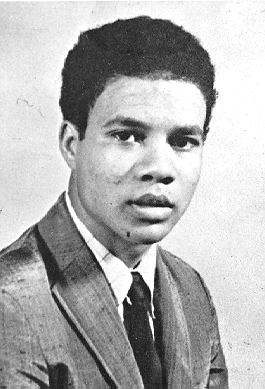 Phillip Lafeyette Gibbs |
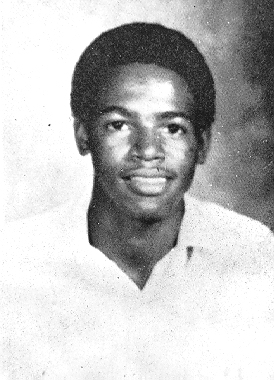 James Earl Green |
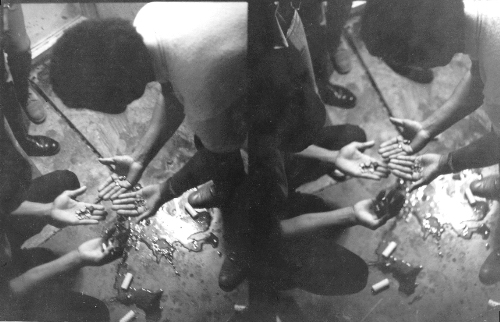
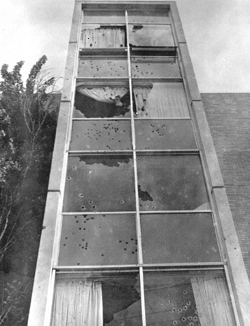 Each window facing the police in the five
story dormitory was shattered. At least 460 rounds were fired on the building, while investigators counted over
160 bullet holes on the outside of the stairwell alone.
Each window facing the police in the five
story dormitory was shattered. At least 460 rounds were fired on the building, while investigators counted over
160 bullet holes on the outside of the stairwell alone. 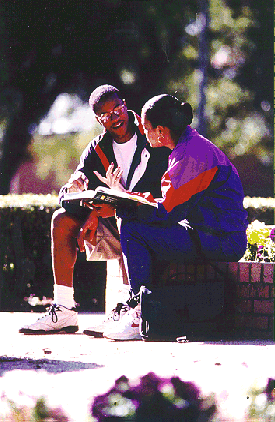 After the closing of Lynch Street, a plaza
was constructed. The Gibbs-Green Plaza, commonly referred to as "Plaza," is a multi-level brick and concrete
structure that blocks off J. R. Lynch Street and lies between Alexander Hall and the University Green. Students
often meet and spend time here in good weather. Jackson State frequently holds outdoor events on the Plaza, such
as dances, concerts, Greek shows, and Homecoming gatherings.
After the closing of Lynch Street, a plaza
was constructed. The Gibbs-Green Plaza, commonly referred to as "Plaza," is a multi-level brick and concrete
structure that blocks off J. R. Lynch Street and lies between Alexander Hall and the University Green. Students
often meet and spend time here in good weather. Jackson State frequently holds outdoor events on the Plaza, such
as dances, concerts, Greek shows, and Homecoming gatherings.
Just north of the Plaza is the Gibbs-Green
Monument, which stands outside of Alexander West dormitory.
In 1995, Demetrius Gibbs, son of Phillip Gibbs, received his degree from Jackson State. He says, "If I try
to tell people about the shootings at Jackson State, they don't know about it. They don't know until I say 'Kent
State.' For us to even be acknowledged, it had to happen at Kent State first."